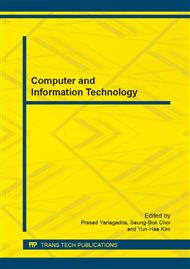[1]
S. Zhang, M. Zhang and X. Ye, Car Plate Character Extraction under Complicated Environment, in Proceedings of 2004 IEEE International Conference on Systems, Man and Cybernetics, 2004, pp.4722-4726.
DOI: 10.1109/icsmc.2004.1401277
Google Scholar
[2]
S. Nomura, K. Yamanaka, O. Katai, H. Kawakami, and T. Shiose, A Novel Adaptive Morphological Approach for Degraded Character Image Segmentation, Pattern Recognition, vol. 38, no. 11, 2005, p.1961-(1975).
DOI: 10.1016/j.patcog.2005.01.026
Google Scholar
[3]
Y. Zhang and C. Zhang, A New Algorithm for Character Segmentation of License Plate, in Proceedings of International Conference on Intelligence Transportation System, 2003, pp.106-109.
Google Scholar
[4]
X. Shi, W. Zhao and Y. Shen, Automatic License Plate Recognition System Based on Color Image Processing, Computational Science and Its Applications-ICCSA 2005, vol. 3483, 2005, pp.1159-1168.
DOI: 10.1007/11424925_121
Google Scholar
[5]
C. Gu and W. Ge, Character Recognition Based on Template Matching Method, Communications Technology, vol. 3, 2009, pp.220-222.
Google Scholar
[6]
S. Nomura, K. Yamanaka, O. Katai, H. Kawakamia and T. Shiose, A Novel Adaptive Morphological Approach for Degraded Character Image Segmentation, Pattern Recognition, vol. 38, no. 11, 2005, p.1961–(1975).
DOI: 10.1016/j.patcog.2005.01.026
Google Scholar
[7]
A. Capar and M. Gokmen, Concurrent Segmentation and Recognition with Shape-driven Fast Marching Methods, in Proceedings of 18th ICPR, Hong Kong, 2006, pp.155-158.
DOI: 10.1109/icpr.2006.400
Google Scholar
[8]
V. Svetnik, A. Liaw, C. Tong, J. C. Culberson, R. P. Sheridan, and B. P. Feuston, Random Forest: A Classification and Regression Tool for Compound Classification and QSAR Modeling, Journal of Chemical Information and Computer Sciences, 2003, vol. 43, p.1947-(1958).
DOI: 10.1021/ci034160g
Google Scholar
[9]
Quinlan JR, Induction of Decision trees, Machine Learning, 1986, vol. 1, no. 1, pp: 81-106.
Google Scholar
[10]
M. Andrew and N. kamal, A Comparison of Event Models for Naïve Bayes text classification, in Proceedings of AAAi-98 workshop on learning for text categorization, (1998).
Google Scholar
[11]
Y. Freund, R. Schapire and N. Abe, A Short Introduction to Boosting, Journal of Japanese Society for Artificial Intelligence, 1999, vol. 14, p.1612.
Google Scholar
[12]
C. Cortes and V. Vapnik, Support Vector Networks, Machines Learning, vol. 20, (1995).
Google Scholar


